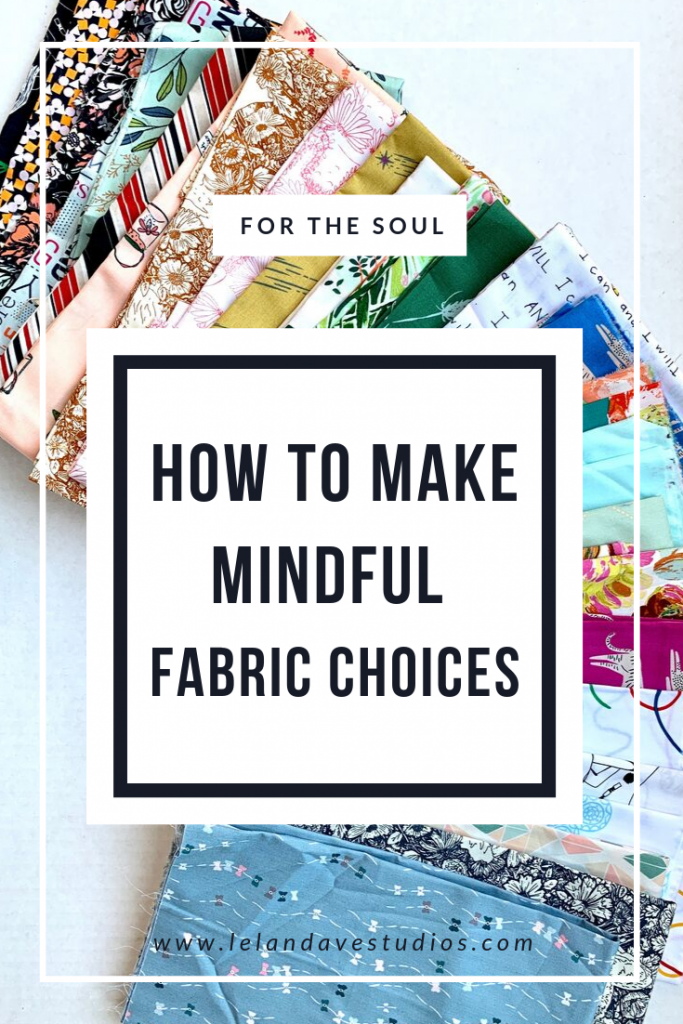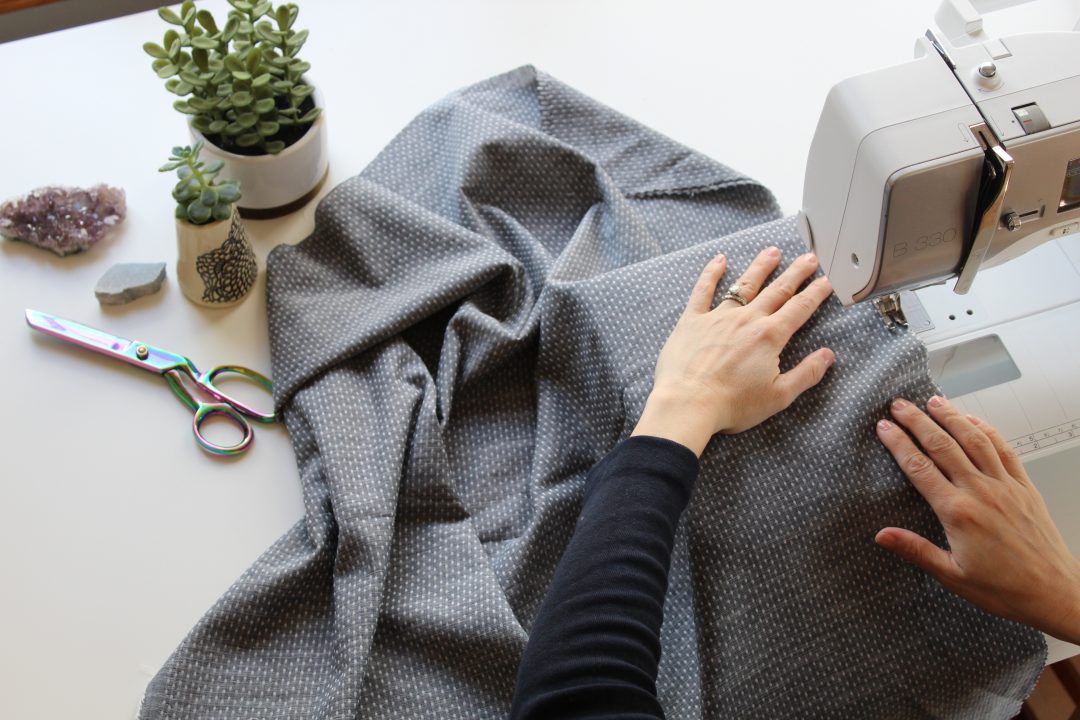As you guys probably know, I spent 2018 curating The Creativity Project: Getting to the Heart of “Why” We Quilt. It was an essential step in my own creative process. It helped me to understand the connection our creativity has to our mind, body, and spirt. But the more attention that I gave to my creative process, the more I felt that it is not enough to just consider “why” we quilt. It is also essential to consider the manner in which we do it. I’ll call this “how” we quilt.
For starters, I should know how fabric is made, in order to have a more meaningful and connected quilting practice. In addition, I’d like to know: how does my hobby as a quilter impact the earth? How does it impact the people that make fabric? Where does fabric waste go (cuttings, excess batting, large unwanted scraps)? Is there is a way for me to be a “better” Maker?
After some research, here is what I learned.
First, The Bad News:
Did you know that the average US citizen throws away approximately 70 lbs of clothing and other textiles per year? Per year! That’s bananas!
It’s also estimated that only 15% of all of that textile waste gets recycled, while nearly 95% of it is probably recyclable. Yikes! That means a lot of waste is just hanging out in landfills, when it could otherwise be re-used. This would preserve our existing resources from being used to make new (unneeded) fabrics. It would provide more room in our landfills. And don’t forget about all of the energy and carbon emissions that we would save by not producing new goods!
The textile industry currently consumes an epic amount of water and energy. From fiber growing and synthesis of fabrics (cotton, in particular, uses an enormous about of water to produce) — to textile dyeing and distribution of the finished product — it all uses water.
In addition, the fabrics we know and love are well-travelled. Very often (with the exception of American Made Brand and maybe a few others — and please, please leave a comment if you have additional information on this), quilting fabrics are printed on the opposite side of the world, and must travel a great distance before making their way into our stashes.
So what’s a conscious-minded consumer to do?
Phew! The Good News:
The good news is that when researching the issue of textile production and waste, I was pleased to learn that great strides are being made to change the current system, particularly in the fashion industry. Here are just a few things as a consumer that you can do to make an impact:
Choose Brands That Use Ethical and Sustainable Practices
Thankfully, sustainability and ethics are more and more frequently becoming a part of the conversation when it comes to textile production. As buyers are becoming aware of the conditions that have become common-practice in the garment and fabric industry, they are shifting where they spend their money to effect change.
Its not enough for fabrics to be produced in a sustainable fashion. It must also be produced under ethical practices, which includes fair wages and working conditions for farmers, suppliers and workers. While things are far from perfect, the conversation has been started. As consumers, we can encourage change by buying from brands that strictly meet this criteria.
Skip the Microfibers
While we quilters typically stick to 100% cotton, there are many fabrics (possibly in our own sewing stash right now) that are made from microfibers. Microfibers shed in the washing machine (fleece would be an example). When washed, tiny plastic fibers are released from the fabric into the washing machine and go down the drain during the wash cycle. These tiny plastic fibers are ending up in our waters and oceans, and as a result in the bellies of animals living in the ocean — including, yup, you guessed it — the fish that we eat. Patagonia, in particular, is working to further research the use of these microfibers in the apparel industry. You can read more about their efforts here.
Repair and Mend
The trend of visible mending is here to stay, and with good reason. Repairing and mending clothes has a huge impact on the environment. It keeps clothes out of landfills, prevents the need for additional clothes which require water and energy to make, and is cost-efficient. The best part is this small change is one that we can adopt right now in our own lives to make a difference for our planet!
Recycle and Upcycle
Recycling is the process of turning waste into new materials and goods. To “Upcycle” fabric means to turn fabric waste into new, even better, goods. There are numerous companies that are developing ways to turn discarded or donated fabrics into new fibers. Known as “closing the loop”, numerous initiatives are underway to produce textiles in a manner where they can be worn, recycled and used again in a continuous cycle.
H&M has been a longstanding leader in clothing take-back programs. H&M currently gives new lives to clothing through resale at second hand stores and by turning garments into new products, such as cleaning cloths. Marine Layer recently launched it’s first line of t-shirts made entirely from old t-shirts they had collected, called Respun. There are numerous municipalities, such as NYC, that require textiles be recycled if they comprise over a certain percentage of a business’ waste. Here in NY, FabScrap works with the garment industry to collect cuttings, unused bolts, samples, etc. and then recycles or sells what it collects to the public.
The Takeaway
I believe that quilting offers us a chance to slow down and to use our hands to create something that takes time to produce. But it’s sometimes hard for me to reconcile the abundance of fabric lines (and how often new ones seem to come out) with the slow and deliberate act of creating a quilt. That’s why it’s important for me to learn more about where my fabric comes from, whether or not it was sustainably and ethically made, and for me to do my part to minimize the impact my fabric waste is having on the planet.
About two years ago, Rachel Hauser of Stitched in Color wrote about the top fabric manufacturers in the quilting industry, and where and how their fabrics are produced. I found that post (and reading a lot of the really knowledgeable comments written in response to it), was a great step toward becoming an informed consumer.
The quickest way to effect change is to vote with our dollars. I truly believe that if we try to be even 10% more thoughtful about our purchasing decisions, together we could have a huge impact on our planet.
I hope that you’ll join me in digging deeper into this topic, and sharing your thoughts and knowledge in the comments section below!







Michelle @ From Bolt to Beauty
October 3, 2019 at 11:37 amI like your about people being 10% more deliberate with their quilting decisions and how we can make a difference together. Otherwise, the truth about how my hobby impacts the planet overwhelms me and I avoid the subject entirely, pretending that I don’t know what I know. I’d also love to learn about fabric options that are made closer to home.
lelandavestudios@gmail.com
October 4, 2019 at 10:54 amI totally understand the feeling of overwhelm. Sometimes it seems easier to stick our fingers in our ears and scream “la, la, la” so that we don’t have to feel bad about yet another decision that we are faced with. Especially when we are taking the time for ourselves to quilt and enjoy “me” time. I will do some research and report back with a post about some of the better options. In the meantime, check out Rachel’s post — she did a thorough job and its a great starting point!
Becky
October 3, 2019 at 10:25 pmWe, the Quilters, are at cross purposes with the manufacturers and our local quilt shops. How to reconcile?
How does one find the recyclers? As an example, who do we send our t-shirts to so they can mfg. cleaning cloths?
And, buying clothes or fabric made from recycled plastic is not eco friendly? What a conundrum we have!
lelandavestudios@gmail.com
October 4, 2019 at 10:52 amI do agree, Becky. It’s so hard to navigate all of the choices we can and “should” make. Sometimes it feels like we are so small, and the problems so big, that our choices won’t even make a difference. But I really do believe that if we all were to work together toward a common effort, our small choices could together change the industry. I think you’ve asked a lot of good questions here, and I will do some research and provide additional information to hopefully address some of them. Thanks so much for your thoughtful response.
Julie
October 6, 2019 at 10:36 amThank you so much for this great article! I recently started doing a lot of research on the environmental impact of the textile industry (huge) for a naturalist project I work with, and that lead me down the specific path of the sustainability of quilting fabric. I’ve contacted a few designers and done quite a bit of reading on the internet, especially on digital printing. There are some recently published books that also address the textile industry as a whole, I can send you the titles if you are interested. The Boulder MQG had a show last fall on Sustainable Quilting which brought up a lot of really good ideas. I didn’t get to see the show, but they have info on their site. My goal is to gather information on the topic and present it to my local guilds in the Kansas City area. I am looking forward to following this very important discussion.
lelandavestudios@gmail.com
October 6, 2019 at 8:56 pmThis is all such great information, Julie! I’d love to hear more of what you’ve found in your research. I, too, have been looking into the way that digital printing will change the industry, and I’d love to hear more of your findings on the subject! Thanks for your thoughtful response, and I will be in touch!
7 Ideas for Eco-Friendly Quilting - LELAND AVE STUDIOS
October 15, 2019 at 6:34 pm[…] and new lines of tempting palettes coming out all the time, it’s hard to think about how our fabric choices can have an impact on the world. It seems so complicated to sift through all of the information out there, and to imagine that tiny […]